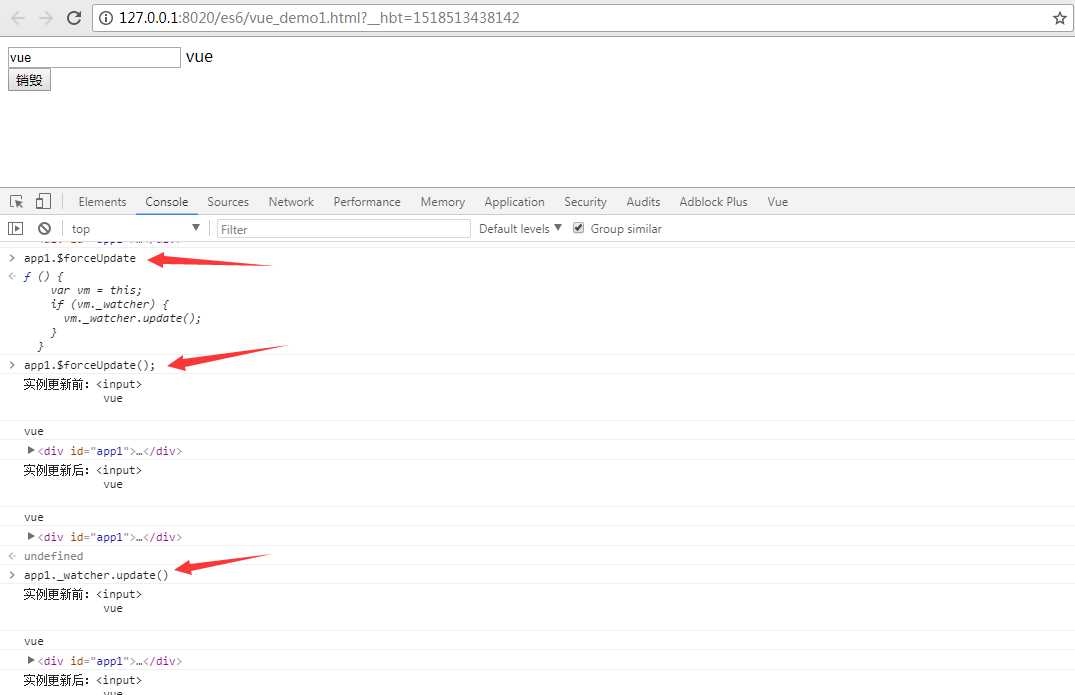1.1、实例生命周期
每个 Vue 实例在被创建之前都要经过一系列的初始化过程。例如需要设置数据监听、编译模板、挂载实例到 DOM、在数据变化时更新 DOM 等。同时在这个过程中也会运行一些叫做生命周期钩子的函数,给予用户机会在一些特定的场景下添加他们自己的代码。
比如 created 钩子可以用来在一个实例被创建之后执行代码:
1 new Vue({ 2 data: { 3 a: 1 4 }, 5 created: function () { 6 // `this` 指向 vm 实例 7 console.log(‘a is: ‘ + this.a) 8 } 9 }) 10 // => "a is: 1"
也有一些其它的钩子,在实例生命周期的不同场景下调用,如 mounted、updated、destroyed。钩子的 this 指向调用它的 Vue 实例。
不要在选项属性或回调上使用箭头函数,比如 created: () => console.log(this.a) 或 vm.$watch(‘a‘, newValue => this.myMethod())。因为箭头函数是和父级上下文绑定在一起的,this 不会是如你所预期的 Vue 实例,经常导致 Uncaught TypeError: Cannot read property of undefined 或 Uncaught TypeError: this.myMethod is not a function 之类的错误。
1.2、生命周期图示
下图说明了实例的生命周期。你不需要立马弄明白所有的东西,不过随着你的不断学习和使用,它的参考价值会越来越高。
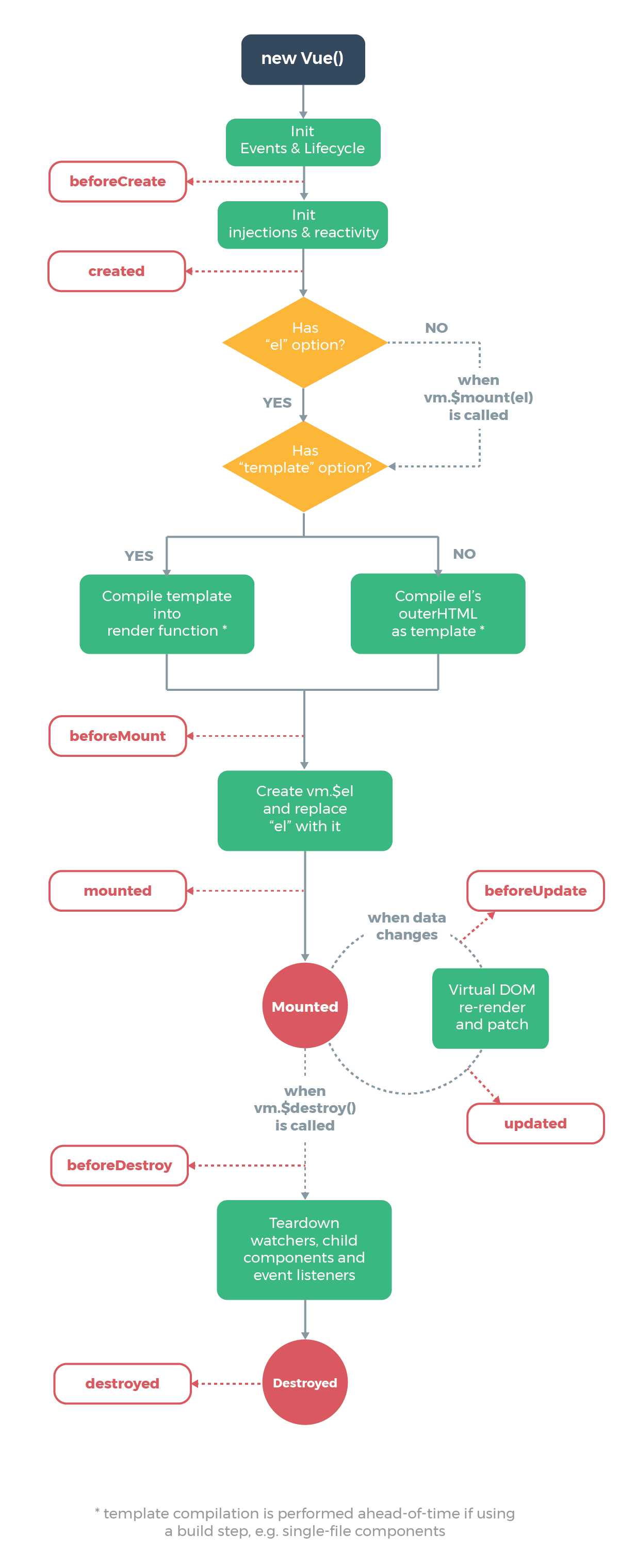
1. beforeCreate
在实例初始化之后,数据观测(data observer) 和 event/watcher 事件配置之前被调用。
2. created
实例已经创建完成之后被调用。在这一步,实例已完成以下的配置:数据观测(data observer),属性和方法的运算, watch/event 事件回调。然而,挂载阶段还没开始,$el 属性目前不可见。 可以在组件的这个期间请求数据,如果是keep-alive组件会被缓存起来,生命周期不会再次触发,如果需要更新数据可以watch当前router变化,如果router是当前组件所在的router则请求数据。
1 methods : { 2 getData : function(id){ 3 ... 4 this.content = ‘test‘; 5 } 6 }, 7 created : function(){ 8 this.getData(this.id); 9 } 10 ... 11 watch : { 12 $route : function(){ 13 if(this.$route.name == ‘xxx‘){ 14 this.getData(this.id); 15 } 16 } 17 }
3. beforeMount
在挂载开始之前被调用:相关的 render 函数首次被调用。
4. mounted
vm.$el已挂载在文档内,对已有dom节点的操作可以在这期间进行。
5. beforeUpdate
数据更新时调用,发生在虚拟 DOM 重新渲染和打补丁之前。
可以在这个钩子中进一步地更改状态,这不会触发附加的重渲染过程。
6.updated
由于数据更改导致的虚拟 DOM 重新渲染和打补丁,在这之后会调用该钩子。
当这个钩子被调用时,组件 DOM 已经更新,所以你现在可以执行依赖于 DOM 的操作。然而在大多数情况下,你应该避免在此期间更改状态,因为这可能会导致更新无限循环。
7.activated
keep-alive 组件激活时调用。
8.deactivated
keep-alive 组件停用时调用。
9.beforeDestroy
实例销毁之前调用。在这一步,实例仍然完全可用。
10.destroyed
Vue 实例销毁后调用。调用后,Vue 实例指示的所有东西都会解绑定,所有的事件监听器会被移除,所有的子实例也会被销毁。
2.生命周期示例一
示例1:
1 <!DOCTYPE html> 2 <html> 3 <head> 4 <meta charset="UTF-8"> 5 <title>Vue2的生命周期</title> 6 <style type="text/css"> 7 // <div> 不会显示,直到编译结束。 8 [v-cloak] { 9 display: none; 10 } 11 </style> 12 </head> 13 <body> 14 <div id="app1"> 15 <input v-model="msg" v-cloak/> 16 {{msg}} 17 </div> 18 <button onclick="destroy()">销毁</button> 19 <script src="https://cdn.jsdelivr.net/npm/vue@2.5.13/dist/vue.js"></script> 20 <script type="text/javascript"> 21 //格式化输出 22 console.log("示例:%c%s","background:red;color:#fff","vue2生命周期","开始了"); 23 console.log("你哈:%c%s,%c%s","color:green;","我是绿色","background:#ddd","我是灰色") 24 var app1 = new Vue({ 25 el:"#app1", 26 data:{ 27 msg:‘vue‘ 28 }, 29 beforeCreate:function(){ 30 console.log("创建前:"+this.msg); 31 }, 32 created:function(){ 33 console.log("创建后:"+this.msg+"."+this.$el); 34 }, 35 beforeMount:function(){ 36 console.log("挂载前:"); 37 console.log(this.$el); 38 }, 39 mounted:function(){ 40 console.log("挂载后:"); 41 console.log(this.$el); 42 }, 43 beforeUpdate:function(){ 44 console.log("实例更新前:"+this.$el.innerHTML); 45 console.log(this.msg); 46 console.log(this.$el); 47 }, 48 updated:function(){ 49 console.log("实例更新后:"+this.$el.innerHTML); 50 console.log(this.msg); 51 console.log(this.$el); 52 }, 53 beforeDestroy:function(){ 54 console.log("销毁前"); 55 console.log(this.msg); 56 }, 57 destroyed:function(){ 58 console.log("销毁后"); 59 console.log(this.msg); 60 } 61 62 }) 63 function destroy(){ 64 app1.$destroy(); 65 } 66 </script> 67 </body> 68 </html>
初始化结果1:
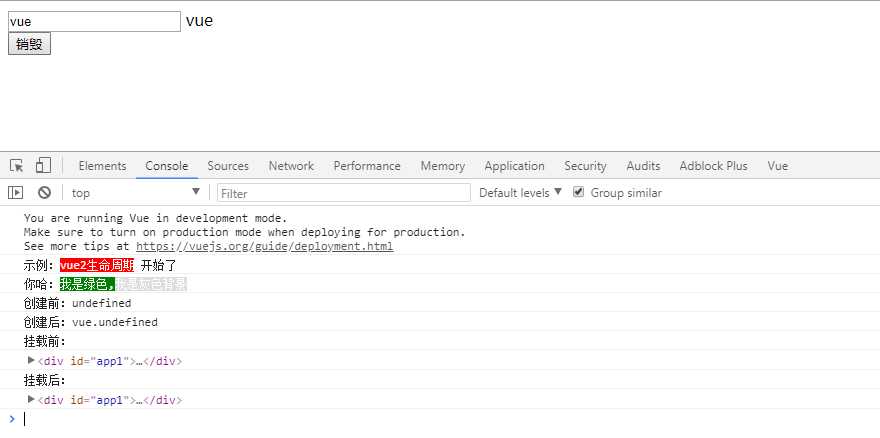
修改msg的值为vue2后的结果:
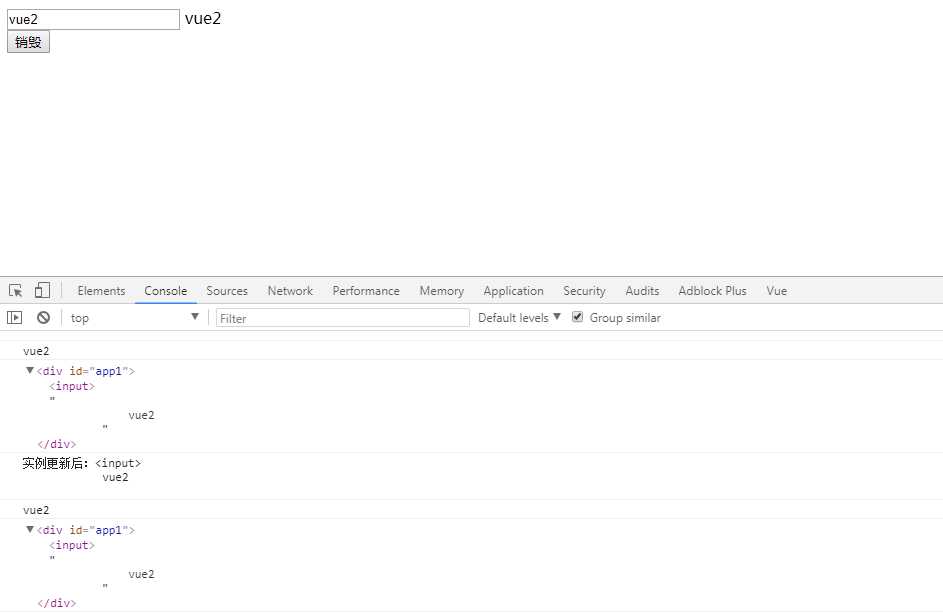
执行销毁:
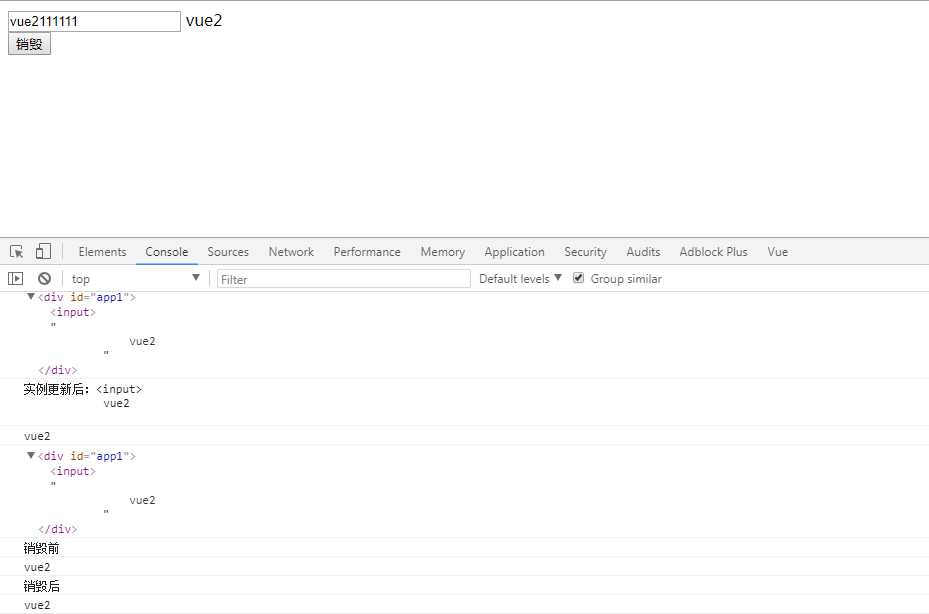
2.1生命周期示例二
示例2:
1 <!DOCTYPE html> 2 <html> 3 <head> 4 <meta charset="UTF-8"> 5 <title>Vue2生命周期</title> 6 </head> 7 <body> 8 <div id="app">{{ message }}</div> 9 <script type="text/javascript" src="https://cdn.jsdelivr.net/vue/2.1.3/vue.js"></script> 10 <script type="text/javascript"> 11 var app = new Vue({ 12 el: ‘#app‘, 13 data: { 14 message: "Study Vue生命周期!" 15 }, 16 beforeCreate: function() { 17 console.group(‘beforeCreate 创建前状态===============》‘); 18 console.log("%c%s", "color:red", "el : " + this.$el); //undefined 19 console.log("%c%s", "color:red", "data : " + this.$data); //undefined 20 console.log("%c%s", "color:red", "message: " + this.message) 21 }, 22 created: function() { 23 console.group(‘created 创建完毕状态===============》‘); 24 console.log("%c%s", "color:red", "el : " + this.$el); //undefined 25 console.log("%c%s", "color:red", "data : " + this.$data); //已被初始化 26 console.log("%c%s", "color:red", "message: " + this.message); //已被初始化 27 }, 28 beforeMount: function() { 29 console.group(‘beforeMount 挂载前状态===============》‘); 30 console.log("%c%s", "color:red", "el : " + (this.$el)); //已被初始化 31 console.log(this.$el); 32 console.log("%c%s", "color:red", "data : " + this.$data); //已被初始化 33 console.log("%c%s", "color:red", "message: " + this.message); //已被初始化 34 }, 35 mounted: function() { 36 console.group(‘mounted 挂载结束状态===============》‘); 37 console.log("%c%s", "color:red", "el : " + this.$el); //已被初始化 38 console.log(this.$el); 39 console.log("%c%s", "color:red", "data : " + this.$data); //已被初始化 40 console.log("%c%s", "color:red", "message: " + this.message); //已被初始化 41 }, 42 beforeUpdate: function() { 43 console.group(‘beforeUpdate 更新前状态===============》‘); 44 console.log("%c%s", "color:red", "el : " + this.$el); 45 console.log(this.$el); 46 console.log("%c%s", "color:red", "data : " + this.$data); 47 console.log("%c%s", "color:red", "message: " + this.message); 48 }, 49 updated: function() { 50 console.group(‘updated 更新完成状态===============》‘); 51 console.log("%c%s", "color:red", "el : " + this.$el); 52 console.log(this.$el); 53 console.log("%c%s", "color:red", "data : " + this.$data); 54 console.log("%c%s", "color:red", "message: " + this.message); 55 }, 56 beforeDestroy: function() { 57 console.group(‘beforeDestroy 销毁前状态===============》‘); 58 console.log("%c%s", "color:red", "el : " + this.$el); 59 console.log(this.$el); 60 console.log("%c%s", "color:red", "data : " + this.$data); 61 console.log("%c%s", "color:red", "message: " + this.message); 62 }, 63 destroyed: function() { 64 console.group(‘destroyed 销毁完成状态===============》‘); 65 console.log("%c%s", "color:red", "el : " + this.$el); 66 console.log(this.$el); 67 console.log("%c%s", "color:red", "data : " + this.$data); 68 console.log("%c%s", "color:red", "message: " + this.message) 69 } 70 }) 71 </script> 72 </body> 73 </html>
初始化结果
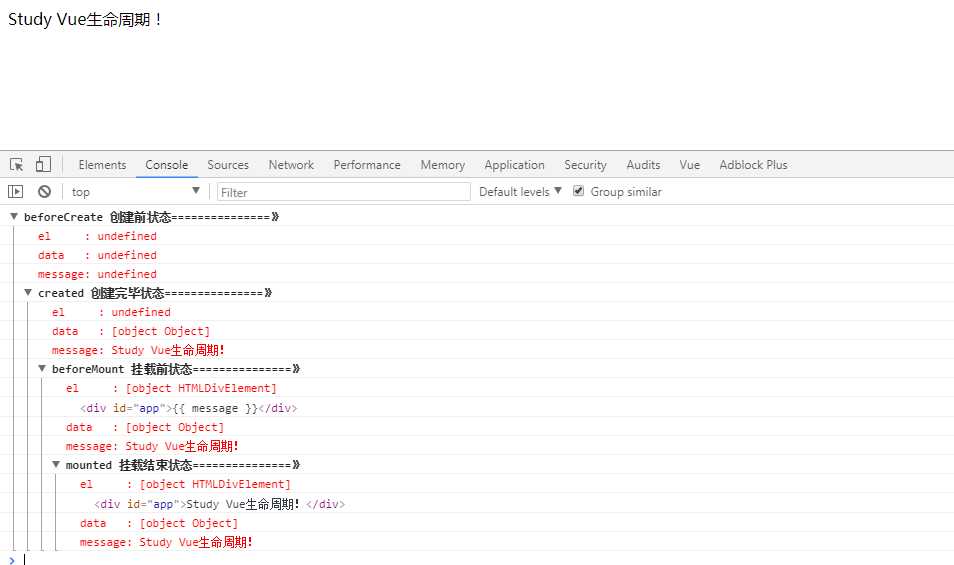
更新message的值:
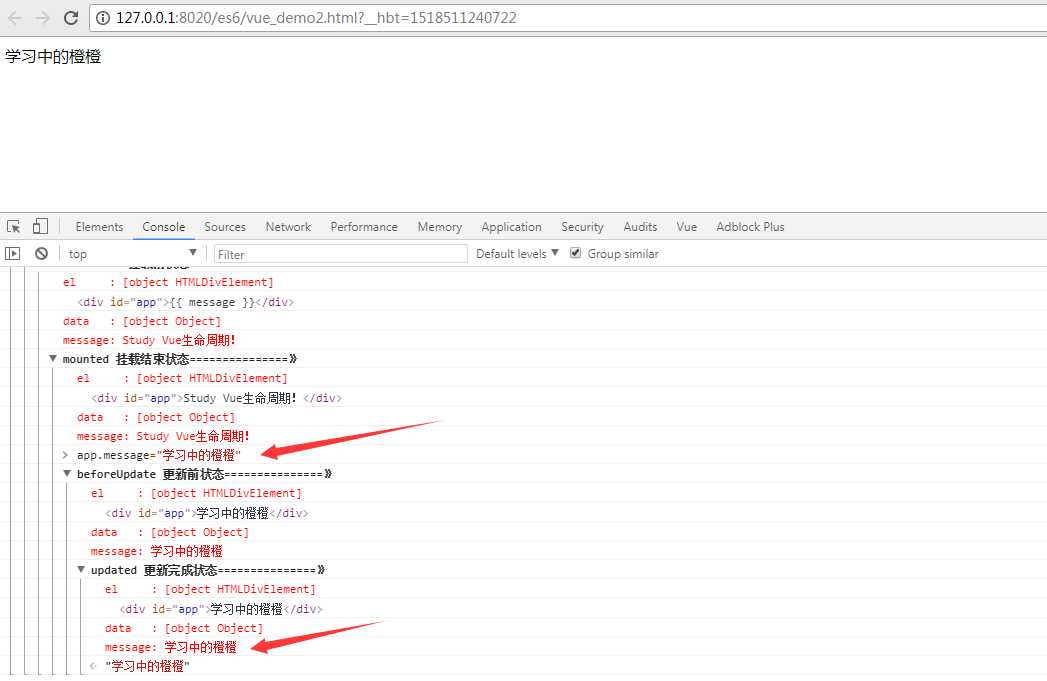
手动销毁实例:
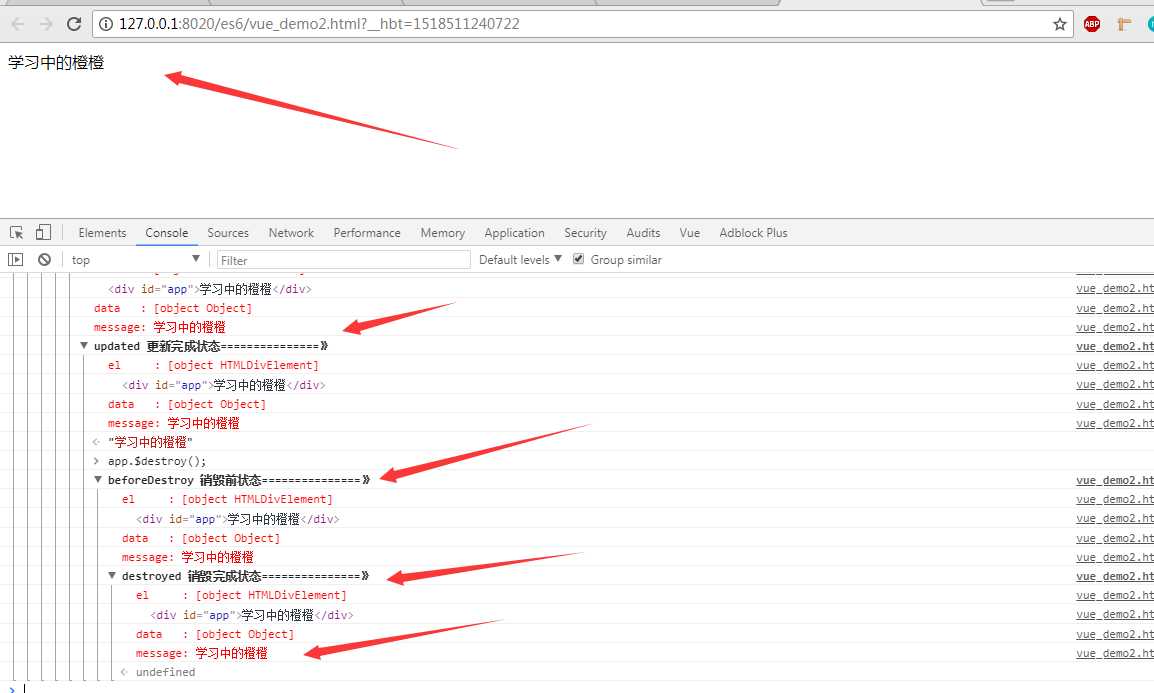
2.2、手动挂载与调用事件
2.2.1、手动挂载
vm.$mount( [elementOrSelector] ) 如果 Vue 实例在实例化时没有收到 el 选项,则它处于“未挂载”状态,没有关联的 DOM 元素。可以使用 vm.$mount() 手动地挂载一个未挂载的实例。
如果没有提供 elementOrSelector 参数,模板将被渲染为文档之外的的元素,并且你必须使用原生 DOM API 把它插入文档中。
这个方法返回实例自身,因而可以链式调用其它实例方法。
1 var MyComponent = Vue.extend({ 2 template: ‘<div>Hello!</div>‘ 3 }) 4 5 // 创建并挂载到 #app (会替换 #app) 6 new MyComponent().$mount(‘#app‘) 7 8 // 同上 9 new MyComponent({ el: ‘#app‘ }) 10 11 // 或者,在文档之外渲染并且随后挂载 12 var component = new MyComponent().$mount() 13 document.getElementById(‘app‘).appendChild(component.$el)
示例:
1 <!DOCTYPE html> 2 <html> 3 <head> 4 <meta charset="UTF-8"> 5 <title>Vue2手动挂载</title> 6 <style type="text/css"> 7 #app1{ 8 color: red; 9 } 10 #app2{ 11 color: blue; 12 } 13 </style> 14 </head> 15 <body> 16 <div id="app1"> 17 <!--<input v-model="msg" />{{msg}}--> 18 </div> 19 <div id="app2"> 20 <!--<input v-model="msg" />{{msg}}--> 21 </div> 22 <button onclick="loaddata1()">手动挂载1</button> 23 <button onclick="loaddata2()">手动挂载2</button> 24 <script type="text/javascript" src="https://cdn.jsdelivr.net/vue/2.1.3/vue.js"></script> 25 <script type="text/javascript"> 26 var app1 = new Vue({ 27 template:"<h2>{{msg}}</h2>", 28 data:{ 29 msg:"Hello Vue2" 30 } 31 }); 32 function loaddata1(){ 33 app1.$mount(); 34 document.getElementById("app1").appendChild(app1.$el); 35 } 36 function loaddata2(){ 37 app1.$mount(); 38 document.getElementById("app2").appendChild(app1.$el); 39 } 40 </script> 41 </body> 42 </html>
结果:

2.2.2、销毁实例
vm.$destroy() 完全销毁一个实例。清理它与其它实例的连接,解绑它的全部指令及事件监听器。
2.2.3、强制更新
vm.$forceUpdate() 迫使 Vue 实例重新渲染。注意它仅仅影响实例本身和插入插槽内容的子组件,而不是所有子组件。
